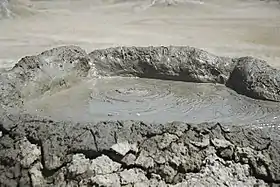Azerbaijani medical tourism
A significant aspect of Azerbaijani tourism industry is medical tourism. Even before the collapse of Soviet Union, Azerbaijan was a popular medical tourism destination and saw many visitors, particularly due to its health spas.
Medical tourism in Azerbaijan
The spas of Naftalan, Azerbaijan attracted roughly 75,000 visitors a year during the height of the 1980s, even though the industry was stunted by the first Nagorno-Karabakh War and the end of Soviet-sponsored spa trips.[1] Since 2008, Azerbaijan has stepped up its efforts to turn itself into a health tourism destination.[2] The National Government's State Program for the Development of Resorts for Medical Tourism has resulted in the opening of medical centers in Baku, Masalli, Nakchivan, Naftalan, and other regions.
Ruslan Guliyev, who leads the Medical Support and the Thermal Tourism Association of Azerbaijan, has said that Azerbaijan is home to curative resources such as therapeutic mud, mineral water, and Naftalan oil, a grade of black oil known for its use in alternative medicine. Treatment is in the form of bathing in this special grade of warm crude oil.[3] Doctors in Azerbaijan have claimed that Naftalan crude baths can cure more than 70 diseases, including skin, joint, and neurological ailments, even though Western Medicine experts have rebutted this claim and stated that the Naftalan crude ingredient naphthalene is possibly carcinogenic.[4] Crude naphthalene (obtained directly from production wells); purified naphthalene (with various additives to increase its density); naphthalene cleaned from resin; naphthenic hydrocarbons; and naphthalene mastic (which consists of naftalan, paraffin, wax, ceresin, and camphor) are all used in these treatments.[5]
The Duzdag Hotel in Nakhchivan, Istisu Masalli, and the Qalaalti Hotel & Spa in Shabran region have been cited as some of the most popular health resorts in the world.[6][7]
Notable Institutes
Nakhchivan Autonomous Republic Hospital
This hospital is named after the region in which it is present. The president, Ilham Aliyev, attended the opening ceremony of the hospital on Dec 1, 2015.[8] The hospital consists of an eight-story building, two auditoriums, seven classrooms, a computer room, a conference hall, a medical and sports center, and medical checkup rooms for students at the time of its inauguration. In addition, there are 14 inpatient departments, 300 beds and more than 130 doctors.[8]
The hospital also has departments of traumatology, emergency and urgent medical care, general therapy, neurology, hematology, eye diseases, otorhinolaryngology, endocrine disorders, proctology, urology, surgery, neurosurgery, resuscitation, and rehabilitation.[8]
.JPG.webp)
Halotherapy in Nakhchivan Autonomous Republic
Since the beginning of the second half of 20th century, world medicine began new treatment methods for bronchial asthma illness in karst caves and salt mines. After further research, doctors concluded that sodium and chlorine ions in salt mines have positive effects on lung bronchial diseases via halotherapy or speleotherapy, both of which are proposed treatments for asthma and other respiratory diseases that involve breathing inside caves.
Professional specialists in various medical fields work at the Duzdag Physiotherapy Center at the Duzdag Hotel, where allergic diseases, especially bronchial asthma, are treated. People from all regions of Azerbaijan, as well as foreign tourists, regularly visit the center.

Mud volcanoes
More than 350 mud volcanoes exist in eastern Azerbaijan and the Caspian Sea region.[9] Volcanic mud is known for having healing properties due to its ingredients such as mineral salts and organic compounds.
Mud-pouring volcanoes can be found in many parts of the world, but one-third of Azerbaijan's mud volcanoes are concentrated within a 16,000-square-kilometer area. Mud volcanoes are most prevalent in the Absheron Peninsula, Shamakhi-Gobustan, Lower Kurian Lowland, Baku Archipelago and near the Georgian border.[10][11][9][12][13]
References
- Kramer, Andrew E. (4 December 2006). "Bathing in Black Gold for Health and Profit in Azerbaijan". The New York Times. Retrieved 31 January 2018.
- Orujova, Nigar. "Azerbaijan strives to become medical tourism destination". www.azernews.az. AZERNEWS. Retrieved 31 January 2018.
- Holodny, Elena. "Taking a bath in warm crude oil is a popular spa treatment in some parts of the world". BusinessInsider.com. Business Insider. Retrieved 31 January 2018.
- Kramer, Andrew E. (4 December 2006). "Bathing in Black Gold for Health and Profit in Azerbaijan". The New York Times. Retrieved 31 January 2018.
- "Naftalan– a magical gift of nature" (PDF).
- "Azerbaijan in Top 5 health tourism destinations". AzerNews.az. 2017-10-03. Retrieved 2018-08-01.
- "Qalaalti Hotel & Spa. Medical center". www.qalaalti.com. Retrieved 2018-08-01.
- "President Ilham Aliyev attended the opening of Nakhchivan Autonomous Republic Hospital VIDEO". Retrieved 2018-02-03.
- "Azeri mud volcanoes - facts & information". www.volcanodiscovery.com. Retrieved 2018-08-01.
- "Largest mud volcano". Guinness World Records. Retrieved 2018-08-01.
- "Mud Volcanoes of Azerbaijan". Atlas Obscura. Retrieved 2018-08-01.
- "GOBUSTAN & MUD VOLCANOES".
- "Aria Medical Tour".